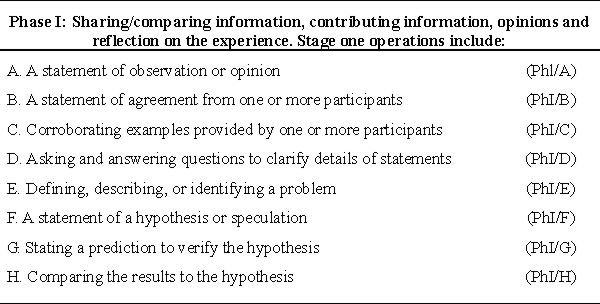
Author
Sandrine Turcotte is currently doing a Ph.D. in educational psychology at McGill University, Montreal. Dr. Thérèse
Laferrière is a professor in the Faculty of Education at Laval
University, Quebec City.
Contact: Sandrine Turcotte, Department of Educational and
Counselling Psychology (ECP), Education Building, Room 513, 3700
McTavish Street, Montreal, Quebec, H3A 1Y2.
Email address: sandrine.turcotte@mail.mcgill.ca.Telephone :
(514) 271-3201
This research paper
describes the use of computer mediated conferencing (CMC) to support
the teaching of biology to undergraduates. The use of this pedagogical
innovation was a first-time experience for both the instructor and his
students. The objectives of this project were to increase students'
active participation, to facilitate collaborative knowledge building,
and to enhance the use of the scientific approach in problemsolving
activities. The data indicate that some positive results were achieved
for each objective. The use of online computer conferences shows a lot
of promise when it is based on reflection, problem-solving,
collaborative learning and knowledge building. Internet conferencing
tools support students as they reflect and work together and open doors
to numerous new educational experiences for both the students and the
professors.
Résumé: Cet article
décrit l'utilisation de forums électroniques de
discussion dans un cours de biologie au premier cycle. Cette innovation
pédagogique fut un précédent pour le professeur
comme pour les étudiants inscrits au cours. Les objectifs
d'apprentissage visés étaient d'augmenter la
participation active des étudiants, de faciliter la
co-construction des connaissances et d'encourager l'utilisation d'une
démarche scientifique dans la résolution de
problèmes. Les données recueillies pointent à des
résultats positifs. Il émerge de cette expérience
que l'utilisation des forums de discussion est prometteuse lorsqu'elle
est basée sur la réflexion, la résolution de
problèmes, l'apprentissage en collaboration et la construction
de connaissances. Les outils de discussion en ligne soutiennent les
étudiants lorsqu'ils réfléchissent et travaillent
ensemble et ouvrent la porte à de nouvelles expériences
éducatives pour les étudiants et les professeurs.
The use of information and communication technologies (ICT) are now
found in all sectors of human activity, including education. At the
postsecondary level, the integration of ICT into the learning process
has become even more important since it provides students with many
opportunities to improve their education. Online collaborative tools
such as discussion forums make it possible to carry out projects as
well as foster rich and constructive interactions between students,
independent of their location, schedule, or any other distance or time
constraint. This case study explores the use of an online discussion
forum in a campus-based science course.
Studies on the impact and effect of online pedagogical resources and tools (Bracewell, Breuleux, Laferrière, Benoit and Abdous, 1998; Fillion, in preparation) reported that learning environments combining facetoface meetings with online work can lead to educational gains such as:
Bereiter and Scardamalia (1993), McGilly (1994), Harasim (1995) and Akers (1997) suggest that the online discussion forum has the potential to generate more higher-order thinking processes than a simple class discussion. Participants in online discussions have time to explore the problem under discussion as well as to reflect on other students' ideas; only then will they build their own understanding of the subject, compose their thoughts and bring them into the forum. Online asynchronous participation also provides students ample time to ponder and argue carefully their own point of view.
The advantages of communication networks do not make interpersonal contacts between students and teachers in traditional classroom situations obsolete. Berge (1995) wrote that it is when computer mediated conferencing (CMC) is combined with traditional classroom activities or to other events such as audioconferences, that a truly effective system of teaching interactions with CMC can exist. Online discussion forums may then be conceived as an important component of a rich learning environment.
In 1987, Chickering and Gamson published the Seven Principles for Good Practice in undergraduate education. These principles, which were based on multiple, higher-education research projects, are still those mostly referred to today. The seven principles are:
Chickering and Gamson (1987) argued for pedagogical contexts that are flexible and offer a number of learning possibilities to students. Our own pedagogical experience in the use of discusssion forums, which goes back to 1996, leads us to believe that the use of online conferences provides pedagogical possibilities that can prove helpful in meeting each and all of the seven principles. Online conferencing increases occasions and ways for students to interact with each other and with faculty. Discussion forums create a shared workspace for students that is conducive to collaborative work between peers. Successful online conferences require students to be active participants. Students must question their own ideas, formulate hypotheses, suggest solutions, defend their point of view, and so forth.
Chickering and Gamson (1987) stated that learning is not a spectator sport. Students learn very little by sitting still in class and listening to the teacher. By talking about what they are learning, linking it to past experiences and applying it to their everyday life, learning increases. Computer conferences offer students the occasion to participate in discussions that are more tuned to their own pace and rhythm. For instance, debates may be launched in order to obtain the opinions of persons who would otherwise remain silent. Textbased communication removes barriers such as self-consciousness and other impediments to effective communication, and it more easily maintains interpersonal exchanges at the level of ideas (Harasim, 1993).
ICT studies are helping to tap the potential of pedagogical approaches built on the socioconstructivist theory. Berge (1995) wrote that the goals of online CMC in teaching are to promote high-quality, active learning based on abilities such as evaluation, analysis and synthesis instead of rote memory. Asynchronous text-based conversations ease the careful consideration and evaluation of messages and foster thoughtful formulations of answers (Harasim, 1993). Results reported by Leidner and Fuller (1997) suggest that collaborative learning via electronic case discussion contributes significantly to students' interest in the course content. Parker (1985) earlier had reported that having students work collaboratively can improve learning, problemsolving abilities and social interactions.
Other early socio-constructivistically-oriented results regarding students' CMC interactions were reported by Cazden (1988) (cited by Ruberg, Moore & Taylor, 1996) :
CMC supports communities of learners who build their knowledge together. A community of learners is a gathering of people who share their knowledge to enhance their abilities and knowledge. Scardamalia and Bereiter (1993) identified some of the features that enhance collaborative knowledge building. The first stresses the importance of a
balance between public and private, and individual and group knowledge processes. Participants need simultaneous access to the work of others to provide comparative models and opportunities to appropriate ideas more advanced than they might think of on their own. (Scardamalia & Bereiter, 1993, p. 39).
For Chickering and Ehrmann (1996), working with others often improves commitment to the learning task. Work groups, collaborative learning, group problemsolving and discussion can be seriously fortified with communication tools that facilitate these activities.
Many researchers (e.g. Bruce, Peyton & Batson, 1993; Berge &
Collins, 1995; Harasim, 1993; Hiltz, 1994; Mason & Kaye, 1989;
Waggoner, 1992, as cited in Kearsley, Lynch & Wizer, 1995) have
concluded that CMC is beneficial in postsecondary settings. In
addition, there is evidence that when students are able to work in a
collaborative learning environment offered via a virtual classroom,
they prefer this environment rather than the traditional classrom
(Hiltz & Wellman, 1997).
Mammalogy, the study of mammals, and particularly their evolution, is a discipline which lends itself to questions which have generated hypotheses that remain to be tested. At Laval University in Quebec City, large numbers of biology students who take this course every year are self-conscious about participating, making studentteacher interaction difficult. Often students are reluctant to ask questions in class and this had caused concern for the professor for some time. The possibility of improving students' participation through use of a computer conference was the main reason for the professor agreeing to participate in the experiment that we wanted to conduct.
Participants were undergraduate students who were familiar with the different components of the scientific method, but seldom had the opportunity to engage in solving genuine problems that require the use of the scientific method. In this course, to resolve an ill-defined problem, the students are invited to use a method composed of three elements: a) statement of a hypothesis, or speculation, b) statement of a predication to verify the hypothesis, and c) comparison of the results with the hypothesis. Inviting students to answer a series of illdefined arguments, or to address unresolved enigmas in mammalogy, was the strategy used to set up the online discussions in this study. Examples of such unresolved enigmas in mammalogy are the absence of lumbar ribs in mammals or the reduction in the number of phalanges. Another example is to ask students to try and explain why humans are the only primates that do not have a baculum (penis bone).
The study was designed to find answers to three questions related to the difficulties of teaching mammalogy to undergraduate biology students. Beyond the immediate mastery of course content, the aspects listed below were of relevance to the professor:
A case study approach involving the collection and analysis of
quantitative and qualitative data was used in this study (Yin, 1994).
This was an exploratory study that looked at a contemporary phenomenon
from different perspectives and gathered evidence from multiple
sources.
Every week during the 1998 Fall term, two or three questions were posted in the conference tool in the form of biological enigmas. The questions were posted in sub-conferences corresponding to the major themes developed in class: introduction to mammalogy, characteristics of mammals, origins and evolution, domestication, teeth, locomotion and reproduction. Students were challenged to answer the questions at a level that went beyond simple speculation. This constraint deserves some explanation. In biology as in many other domains, there are many questions that remain unanswered, such as the sequence and mechanism of the evolution of mammals. It is not sufficient to propose an explanation unless the explanation contains the different elements necessary to speculate, predict and verify as required by the scientific method. To encourage students' participation, it was decided that every posting would be assessed and that some credit would be granted depending on the quality of the content. To encourage online participation, the professor would take some time in class every week to discuss some of the answers and ideas posted online. For this first use of online conferencing, the professor chose not to intervene online himself but rather to discuss the different topics in class.
Several authors have developed an analysis model to evaluate transcripts drawn from computer conferences (Henri, 1992a, 1992b; Gunawardena, Lowe & Anderson, 1997; Calvani, Sorzio & Varisco, 1997; Kanuka & Anderson, 1998). These models usually define a group of factors which can be identified in the text and help identify different types of content encountered.
We chose to use the interaction analysis model proposed by Gunawardena et al. (1997) because it seemed to be the most complete and appropriate at that time. The model proposed by the authors defines five phases that correspond to five phases of development in the knowledge construction process observed during an international online debate. This model enables us to identify the different elements of a discourse through phases that correspond to a progression in the thought building process. Each phase develops into a set of operations that are used to identify the elements of meaning contained in the discourse.
Gunawardena et al. (1997) have made it clear that their model could be improved. Thus, we slightly modified it because the original model was based on an online debate format. In a debate format, both sides must come to an agreement at the conclusion of the debate. In the present case, the later phases of negotiation of meaning and agreed upon statements are not prerequisites for participation in the mammalogy conference. Also, three new elements addressing the use of a scientific approach to problemsolving were added to the model and will be described later.
The conference transcripts were analysed to assess the extent students built on each other's knowledge and to identify the proportion of postings that made explicit use of the elements of the scientific approach. Student participation was first evaluated in terms of the number of site visits and to the number of forum postings. The quality of participation was also evaluated, with differential values being attributed to initial answers to the questions, and to further contributions based on other students' postings.
The content of postings was evaluated using an adapted version of Gunawardena et al.'s interaction analysis model for examining social construction of knowledge in computer conferencing (1997), to identify the dominant type of interactions fostered in this conference. This model was also used to verify if students had used a scientific approach to solve problems in their postings (Tables 1-5).
In order to assess the use of the scientific approach, three principal elements were identified by the professor and added to the model. The elements added to Phase I are related to the statement of a hypothesis, the statement of a prediction verifying this hypothesis, and the comparison of results against the hypothesis. The same elements were added to Phase II as they apply to the alternate hypothesis.
All postings were coded according to the elements of meaning found
in each posting. Elements of meaning are any part of a message that
presents an opinion, a thought, or a new hypothesis. The elements were
tallyed and the results used to evaluate the content in the
subconferences. Two other researchers analyzed part of the messages and
the high interresearcher concordance confirmed the stability of the
results1 . The interaction analysis model identifies in which
phases the discourse was situated throughout the experiment. This has
proven to be helpful in defining the type of discourse that was most
frequently used in the conference and determining the progression of
the postings through the different phases of the model.
Table 1.
Adaptation of the Interaction Analysis Model for Examining Social
Construction of Knowledge in Computer Conferencing (Gunawardena et al.,
1997).

Table 2.
Adaptation of the Interaction Analysis Model for Examining Social
Construction of Knowledge in Computer Conferencing (Gunawardena et al.,
1997).

Table 3.
Adaptation of the Interaction Analysis Model for Examining
Social Construction of Knowledge in Computer Conferencing (Gunawardena
et al., 1997).
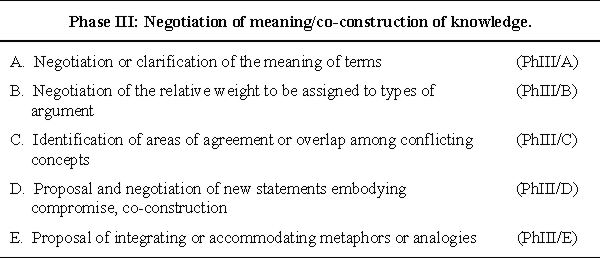
Table 4.
Adaptation of the Interaction Analysis Model for Examining Social
Construction of Knowledge in Computer Conferencing (Gunawardena et al.,
1997).
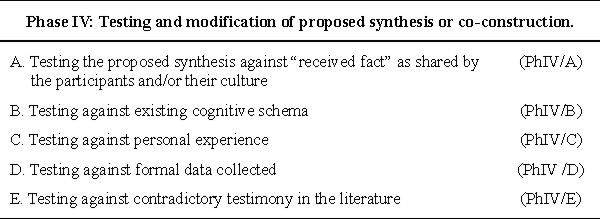
Table 5.
Adaptation of the Interaction Analysis Model for Examining Social
Construction of Knowledge in Computer Conferencing (Gunawardena et al., 1997).

Eighty-two students were enrolled in the Mammalogy course. Sixty-nine students completed the questionnaire in September (the beginning of the term) and 72 completed the questionnaire distributed in December (the end of the term). Three per cent of the students had never used CMC in class, 36 % had already participated in a videoconference or a chat session and 76 % were experienced Internet users. Thirty-nine per cent said that the course format influenced their decision to continue their studies in biology.
After the mammalogy conference activity, 94 % of the students thought that the opportunity to use CMC in a biology course was interesting. Ninety per cent believed the use of computer conferences in the course was useful in their learning process even though only 3 % of them had used it before.
Table 6 presents general results describing the integration of CMC
in the mammalogy course. Participation in the conference was not
compulsory but a maximum of 5 bonus points on the overall mark of the
course could be earned from participating. Forty-two out of 82 students
(51 %) posted at least one written entry in the conference. Two hundred
and forty entries were posted in the general conference and its
sub-conferences, including 24 questions from the teacher and six
informative postings. Altogether, there were 198 discrete postings with
significant content. Individually, participants posted 1 to 15
messages, with a mean of 4.7 postings per student (Table 7). These
postings were graded from 0.5 to 5 points, mean = 2.1 points per
student. Considering the fact that the students could only get as much
as 5 bonus points for their entire postings, that the questions
explored in the forum were not going to be part of the exams and
because this was a first trial with online forums for the majority,
including the instructor, the 50% participation rate is higher than
expected.
Table 6.
Student Participation to the Mammalogy Conference and
SubConferences.

Table 7.
Average Individual Participation of
Students in the Conference.

T test statistics on the average final results of the two groups of students - students who chose to participate in the conference (80.64 %) and nonparticipant students (74.48%) - show that the difference is statistically significant at a p<0.01 value. One way to look at it could be that the participation in the online conference may have helped the students with their exams, even though none of the topics discussed online was part of the examination. The skills learned in the conference setting may have helped students to ponder and argue their thoughts while writing their exams. But the significant difference may also be due to motivated students willing to try something new or to high achievers interested in earning bonus points or it may be that only the stronger students volunteered to participate. Since it was a first experience, confirmation of these results are required before concluding on this particular matter.
Eighty-three per cent of participants responded that they found the experience useful and thought the possibility of using communication technology to study biology was interesting. Eighty-two per cent of the students reported that they appreciated the class discussions regarding the computer conference, even if they did not participate in the conference. In an effort to estimate the value they gave to this innovative activity, we asked students if they wanted to use CMC in other classes. As many as 70 students hoped they would use computer conferences in other classes.
Students' willingness to ask questions in class is an obvious sign of the students' participation in class. In the first questionnaire, 25 % of the students in the course reported asking questions in class. In contrast, half of those who did not pose questions in class explained that they were not comfortable enough. These reports were corroborated by the professor who felt that as the years passed, he was asked fewer questions. During the term, 83 % of the students in the class logged in at least once. Seventy-three per cent of the students used the online conference, to write a message or to read some of the postings; 51 % of the students wrote at least one message during the conference, they were considered to be the participating students. While about a quarter of the students in this class reported being comfortable enough to ask a question in a traditional classroom environment, twice as many chose to express themselves via the conference.
A content analysis of the postings using the modified model of Gunawardena et al. indicated the different types of messages posted by the students and is presented in Table 8. Distinguishing the postings that are first-degree replies from those that build on other students' messages helps to assess what proportion of the postings were built on another student's message. A first-type contribution replied directly to the question posted in the conference. A second-type contribution is a message that responds to another student's reply (or first-type contribution) to the question posted online. A third-type contribution is a message that responds to a student's second-type contribution and so on. An example of a third-type contribution is if student C posts a comment building on student B's reply to student A's answer to question 1. By contributions we mean postings that either answer the posted question (student A's posting in the previous example) or complete another student's posting (students B and C postings)2 .
Table 8.
Distribution of the Types of Postings for Each Sub-Conference.
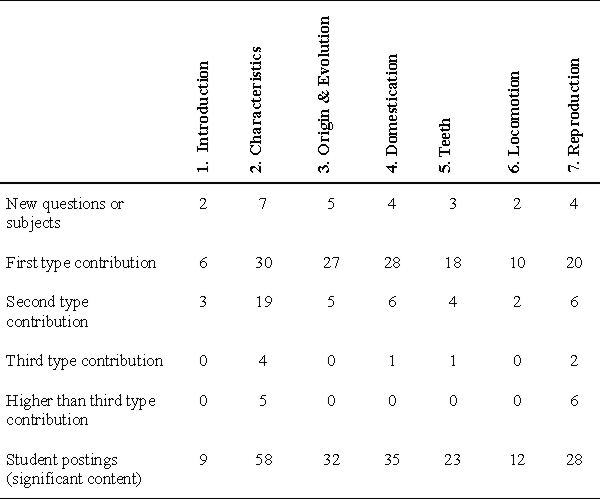
Figure 1 shows the distribution of the types of postings :
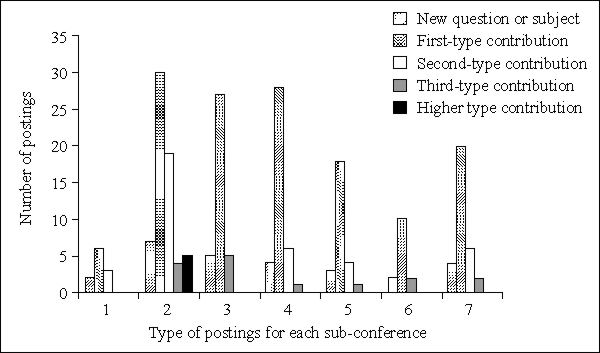
The histogram indicates that the majority of postings are of the first contribution type (70 %). Twenty-three of the messages are of the second contribution type, while messages of the third contribution type represent 4 % of the postings. Finally, 5 postings (3 %) were of a higher level than a third-type contribution. Considering the pedagogical formula of the forum, which consisted of answering questions posted to the forum, it is not surprising to see so many postings of the first type and fewer postings of higher type postings. It is interesting to note that, in almost one out of four instances, the students did not keep to just answering the questions. Rather, they made an effort to build on their colleagues' answers even though they had no experience with CMC, and they were not guided by a facilitator in the forum.
A cursory analysis shows some evidence of the socialconstruction of knowledge in the mammalogy conference. Evidence includes the distribution of the different types of messages, responses to the professor's questions, and responses that are building upon the statements of other conference participants.
Every message with significant content was further analyzed with the
interaction model. All of these messages were coded following the
requirements of the model and the elements of meaning that were
identified. Following the coding
of the elements of meaning found in the postings of every
subconference, it was possible to construct two tables (Tables 9 and
10) showing the elements of meaning found in each of the different
phases of the modified model of Gunawardena and colleagues.
Table 9.
Distribution of the Elements of Meaning for Each SubConference
(Phase I).

Table 10.
Distribution of the Elememts of Meaning for Each Sub-Conference
(Phases II and III).
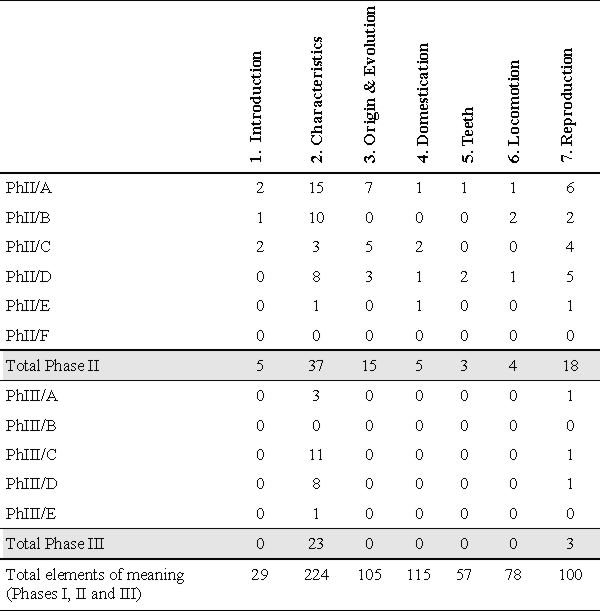
In each subconference, students built on each other's solutions to
some extent. The fact that the discussion remained at the first three
phases of the modified model was predictable since the model was first
developed to evaluate debates for which there must be a closing
argument. Such constraints were not relevant in this particular
pedagogical setting. This explains the absence of elements of sense for
Phases 4 and 5 of the analysis model for the entire postings to the
mammalogy forum. Despite this fact, the analysis model from Gunawardena
and colleagues was still considered to be the most appropriate for this
study. Figure 2 plots the data drawn from Tables 9 and 10.
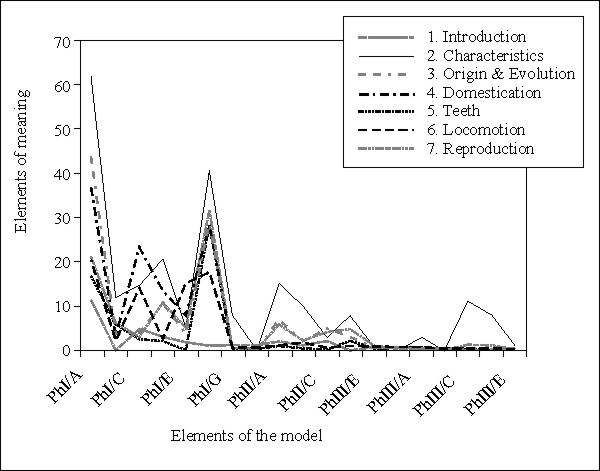
Figure 2. Distribution of elements of meaning from the first three phases of the model.
The more one advances through the different phases of the model, the
fewer elements of meaning one encounters. This figure shows that the
phases of the model that appear most frequently are statements of
opinion or observations (PhI/A), corroborating examples provided by
other participants (PhI/C), and questions and answers intended to
clarify details of statements (PhI/D). A large portion of the postings
correspond to the element PhI/F, a statement of a hypothesis or
speculation.
Throughout the term, the professor reinforced the importance of using a scientific approach to corroborate every speculation. We evaluated whether the students used a scientific approach to corroborate their contributions. We used the modified interaction model, and placed emphasis on the elements that were added to the model in order to identify the use of the scientific approach in the students' contributions. Table 11 presents the distribution of the elements of meaning specific to the scientific approach (elements F, G and H added to Phase I of the original model and elements D, E and F added to Phase II).
The data indicate that if students are able to state hypotheses
(PhI/F and PhII/D), it was more difficult for them to construct
predictions that could be used to verify these hypotheses (PhI/G and
PhII/E). Examination of the results of their predictions with their
hypotheses (PhI/H and PhII/F) occurred only once.
Table 11.
Elements of Meaning Corresponding to the Use of a Scientific
Approach.
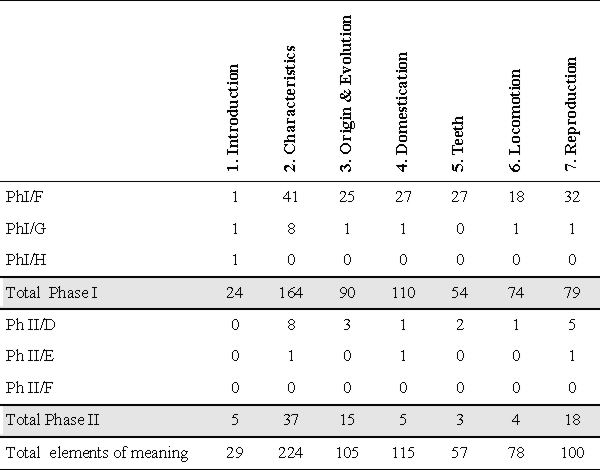
The professor found many positive aspects regarding his experience with CMC. First, he felt the experience was generally a success because of the percentage of students (51%) who participated in the online conference. He felt that the students were much more active than they usually are in a traditional classroom setting.
The professor very much appreciated the online contact with the students. He thinks that typically there are too few occasions for students to interact with their teachers. With the conference, the students can take time to reflect before contributing, which in return makes for richer and more solid interventions. The conference also offered the professor a means to discover what the students were thinking at different times during the term. Thus, he could identify the concepts or parts of the course that were not understood by the students or needed further explanations. The professor also received feedback regarding his teaching. The professor appreciated the possibility to maintain an ongoing discussion on certain aspects of the course content throughout the term, as it was possible to return to a problem weeks after it was discussed in class.
The online computer conference enabled students to practice skills rarely used in a traditional classroom environment. For example, they were able to address questions that remain unanswered in the literature in a context that is better suited for reflection and argumentation than the more traditional setting of a lecture theatre. While it is unthinkable to ask students to answer such questions in a traditional examination, these questions are common in real life. Participating students lived an authentic research experience because they were challenged to find plausible answers to authentic research questions.
The professor also believed that the conference was able to simulate the long process of reflection which underlies any genuine research activity. Because it was a key success factor of the activity for the professor, particularly in regards to the quality of the postings, he stressed the importance of the reflection time allowed by the asynchronous collaborative tool.
The skills required for participating in the conference were complex
and in his opinion, the online conference attracted a particular type
of student. He believed students with particular problem-solving skills
and unusual creativity sometimes generated very intelligent
interventions. Students became more capable of thinking by themselves
and discussing their ideas with the other students.
Online learning, as experienced with online computer conferences in undergraduate education, is an unfolding pedagogical innovation. The experiences using the electronic network are increasingly diverse and they are slowly defining a new culture of learning leading to different pedagogical approaches. It is time to take stock and to review the many lessons learned.
First, undergraduate students are open to this type of learning activity and they are not surprised to be asked to use technology and particularly the electronic network, for their education. The same is true for many faculty. The professor who participated in this study was not computer savvy and was not familiar with online conferences. Nonetheless, he accepted the invitation to participate. Intuitively, he expected that teaching stood to gain with the use of technology.
The integration of an online conference into a mammalogy class made it possible to experience unusual teaching in a particular postsecondary context. The mammalogy conference adapted itself to the constraints of the subject matter and offered both students and professor a new and stimulating learning experience. The results of this study illustrate the many facets and contributions of this innovation to the enrichment of teaching and learning.
The students who participated in the conference have taken a more active part in their learning process than those who did not by speaking up, reflecting on the problems posted, constructing their own solutions to the problems, and submitting them to their peers. The mammalogy conference offered students an opportunity to take an active role in their course. The unanimous agreement of participating students speaks in favor of the achievement of this first learning goal. The authors acknowledge the possibility of the Hawthorne effect, but think that further research in the field should provide more information on that matter. In the meanwhile, the results of this study can give us an idea of the reaction of students to this type of innovation.
The data show that social construction of knowledge occurred. Students were invited to build on each other's contributions to solve the illdefined questions posted to the conference and the process generated rich exchanges around these questions. This activity could have been further optimized if for example, we had insisted that each and every contribution to the conference be addressed, or if there had been a facilitator to moderate the conference.
The class discussions enabled the professor to review some of the aspects discussed in the conference that needed further explaining or that had to be examined from another perspective. Thus the conference not only changed the way students learned, but also modified the teaching practice of the professor. The class discussions regarding the online conference also helped to explore the curriculum in a different manner, building bridges between the online endeavours and the activity in the classroom. It seems that the use of CMC in this course provided students with the opportunity to build their knowledge of mammalogy together as well as their skills with online conferencing technology.
The enhancement of problemsolving skills using a scientific
approach was no that well served by the experimental strategy chosen to
conduct this research. Leaving the students to themselves in the online
conference did not provide the kind of moderation or facilitation that
could have reinforced the use of particular elements of meaning
associated with the scientific approach (PhI/F, PhI/G, PhI/H, PhII/D,
PhII/E and PhII/F).
The importance of the learning context before defining the appropriate use of CMC is particularly relevant to this discussion. Even when CMC offers multiple possibilities as an intellectual working tool, no single pedagogical method can be used in all contexts. It is extremely important to take into account not only the learning context, but also the precise learning goals that can be reached with the use of computer conferences. Sufficient consideration of these two aspects does not guarantee the success of electronic conferences, but it does help to enhance their utility and their rates of success.
Laferrière, Breuleux and Campos (1999) described seven pedagogical formulas commonly used on campuses with computer conferences, illustrating the flexibility of these tools and the diversity of the new practices that can be associated with current pedagogical settings. Based on the work of Laferrière, Breuleux and Campos (1999), the mammalogy computer conference could be classified into the first type of activity, a traditional lecture combined with the use of online tasks. These authors have observed a greater interest for the mixed mode using both online and facetoface activities in experiments they have conducted in many postsecondary contexts.
The integration of CMC as a mixed mode in traditional university settings is becoming more and more prevalent. Not only is its value as a learning tool in distance education recognized but it is also accepted as a worthwhile learning activity in traditional education based face-to-face meetings. We believe that the use of online collaborative tools adds significant value to the learning experience and that a growing knowledge of its use can only be beneficial. In the foreseeable future, the progressive integration of computer conferencing in postsecondary contexts is likely to bring changes in the students' as well as the teachers' practices.
The use of online computer conferences shows a lot of promise when it is based on reflection, problem-solving and collaborative learning. The existence of tools capable of supporting the processes of student reflection and collaboration, when combined with the flexibility offered by networks, opens doors to numerous new experiences for both the students and the professors.
The integration of a computer conference in the mammalogy course not
only improved the participation of students but it also enriched the
content of the class activity, as assessed by both the students and the
professor. In this trial of CMC in the teaching of biology to
undergraduates, online computer conferencing proved to be easily
integrated into the course. This innovation, beyond attaining its
learning goals, was highly appreciated by the students who found it
very helpful. The professor recognized that the conference improved his
teaching and is determined to use CMC in the future.
The authors would like to thank Dr.Cyrille Barrette for his
contribution to this study.
Akers, R. (1997, August). Web discussion forums in teaching and learning. Microsoft in higher education: Case studies.
Bereiter, C., & Scardamalia, M. (1993). Surpassing ourselves: An inquiry into the nature and implications of expertise. La Salle, IL: Open Court.
Berge, Z. L. (1995). Facilitating computer conferencing: recommendations from the field. Educational Technology, 35, 22-30.
Berge, Z. L. and Collins, M. P. (1995). Computer Mediated Communication and the Online Classroom. Volumes 1-3. Cresskill, NJ: Hampton Press.
Bracewell, R., Breuleux, A., Laferrière, T., Benoit, J. & Abdous, M. (1998). The emerging contribution of online resources and tools to teaching and learning. Ottawa: SchoolNet.
Bruce, B.C., Peyton, J.K. & Batson, T. (1993). Networked-Based Classrooms: Promises and Realities. NY: Cambridge University Press.
Calvani, A. , Sorzio, O. & Varisco, B. M. (1997). Inter-university cooperative learning: an exploratory study. Journal of Computer Assisted Learning, 13(4), 271-280.
Cazden, C. (1988). Classroom discourse. Portsmouth, NH: Heinemann.
Chickering, A. W., & Ehrmann, S. C. (1996, October). Implementing the seven principles: technology as lever. AAHE Bulletin. 49(2), 3-6.
Chickering, A.W., & Gamson, Z. F. (1987, March). Seven principles for good practice in undergraduate education. AAHE Bulletin, 39(7), 3-7.
Fillion, G. (en préparation). Revue des travaux existants. L'intégration des TIC dans la formation universitaire : une étude des résultats éducationnels des étudiants dans les contextes de présence et de non présence en classe. Thèse de doctorat. Université Laval.
Gunawardena, C. N., Lowe, C. A. & Anderson, T. (1997). Analysis of a global online debate and the development of an interaction analysis model for examining social construction of knowledge in computer conferencing. Journal of Educational Computing Research, 17(4), 397-431.
Harasim, L.M. (1993). Networlds: Networks as social space. In L. Harasim (Ed.), Global networks: Computers and international communication (pp. 15-34). Cambridge, MA: MIT Press.
Harasim, L. (1995). Learning networks: A field guide to teaching and learning online. Cambridge: MIT Press.
Henri, F. (1992a). Computer conferencing and content analysis. In A. Kaye (Ed.) Collaborative learning through computer conferencing: The Najaden papers, (pp.117-136). London: Springer-Verlag,
Henri, F. (1992b). Processus d'apprentissage à distance et téléconférence assistée par ordinateur : essai d'analyse. Canadian Journal of Educational Communication, 21(1), 3-18.
Hiltz, S. R. (1997, August). Impacts of college-level courses via asynchronous learning networks: some preliminary results. Journal of Asynchronous Learning Networks, 1(2). Retrieved May 6th, 2004, from http://www.sloan-c.org/publications/jaln/v1n2/v1n2_hiltz.asp
Hiltz, S. R., & Wellman, B. (1997). Asynchronous learning networks as a virtual classroom. Communications of the ACM, 40(9), 44-49.
Kanuka, H. & Anderson, T (1998). Online social interchange, discord, and knowledge construction. Journal of Distance Education, 13(1), 57-74.
Kearsley, G., Lynch, W., & Wizer, D. (1995). The effectiveness and impact of computer conferencing in graduate education. Educational Technology, 35, 37-42.
Laferrière, T., Breuleux, A. & Campos, M. (1999). L'évolution des métiers et des formations dans les nouvelles méthodes de production de connaissances. L'apprentissage en réseau, une réalité à définir. Agence universitaire de la francophonie.
Leidner, D.E., & Fuller, M. (1997). Improving student learning of conceptual information: GSS supported collaborative learning vs. individual constructive learning. Decision Support System, 20(2), 149-163.
Mason, R. D. & Kaye A. (1989). Mindweave: Communication, Computers and Distance Education. Pergamon Press.
McGilly, K. (dir.). (1996). Classroom lessons: Integrating cognitive theory and classroom practice. Cambridge, MA: The MIT Press.
Parker, R.E. (1985). Small-group cooperative learning: improving academic, social gains in the classroom. NASSP-Bulletin, 69(479), 48-57.
Ruberg, L.F., Moore, D.M., & Taylor, C.D. (1996). Student participation, interaction, and regulation in a computer-mediated environment: a qualitative study. J. Educational Computing Research, 14(3), 243-268.
Scardamalia, M., & Bereiter, C. (1993). Technologies for knowledge-building discourse. Communications of the ACM, 36(5), 37-41.
Yin, R. K. (1994). Case study research: Design and methods (2nd
ed.). Thousand Oaks, CA: Sage.
1. The interrater agreements range from 0.69 to 0.85 for these messages.
2. One posting can be both a first and a second type contribution if it answers to two messages at once.
© Canadian Journal of Learning and Technology